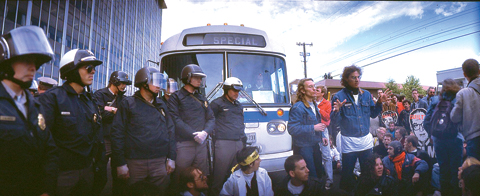
A VIEW OF THE PAST Recalling the activism of the '80s and '90s. |
More than 30 "archival cinematographers" are credited at the end of David France's Oscar-nominated documentary, How to Survive a Plague. They are the men and women who were at the frontlines during the terrifying time between the early '80s and the mid-'90s, when the AIDS epidemic was decimating a community without a cure, or even effective treatment, in sight. They are the ones who chose to use what was then a new technology (camcorders) to record the battle of their lifetimes; the resulting footage allows us to bear witness to a dark time in US history, when elected officials ignored the cries of the sick and activists were forced to take public-health policy into their own hands.
France, a journalist and author who wrote the first story about the AIDS activist group ACT UP for the Village Voice, relies primarily on that archival footage, combined with some more recent interviews, to bring the viewer into the trenches. We see the nascent days of the ACT UP movement — a Wall Street demonstration in 1987 protesting the high cost of the (questionably effectual) AIDS drug AZT ($10,000 for a year's worth!); a 1989 "kiss-in" at New York City's St. Vincent's Hospital to protest violence and apathy toward people with AIDS, gays, and lesbians — and watch as the group becomes increasingly brazen and powerful. We attend, as flies on the wall, impassioned meetings at the Lesbian and Gay Community Center in Greenwich Village. We observe, breathless, as playwright Larry Kramer (author of the searing The Normal Heart, which Mad Horse Theatre Company produced in Portland in 2010) excoriates fellow ACT UP-ers, begging them to cast aside petty grievances and remember that "we are in the middle of a plague. Forty million infected people is a plague."
Yes, there was in-fighting; yes, there were power struggles. The documentary delves into those, too, serving to remind us that no meaningful protest movement develops without internal strife. One minor criticism: It is ironic that while ACT UP and its spin-off organization, the Treatment Action Group, called for more drug trials involving women and people of color, the film fails to fully represent those people's experiences in its version of history.
This story does, of course, have something of a happy ending. By the mid-to-late '90s, combination therapy appeared to be working as a treatment for HIV and AIDS. But not before the epidemic claimed the lives of hundreds of thousands in the United States (and millions worldwide).
They didn't go down without a fight. How to Survive a Plague shows us how a core group of active, largely HIV-positive people taught themselves the science of AIDS — virology, biology, pharmaceutical chemistry. Despite the fact that many were sick and all were scared (or perhaps because of it), they brought their knowledge, along with their demands, straight to the top: to the Food and Drug Administration, the National Institutes of Health, the 1992 candidates for president. That most of these confrontations are shown in the moment, rather than described after the fact, is what makes this documentary so powerful.